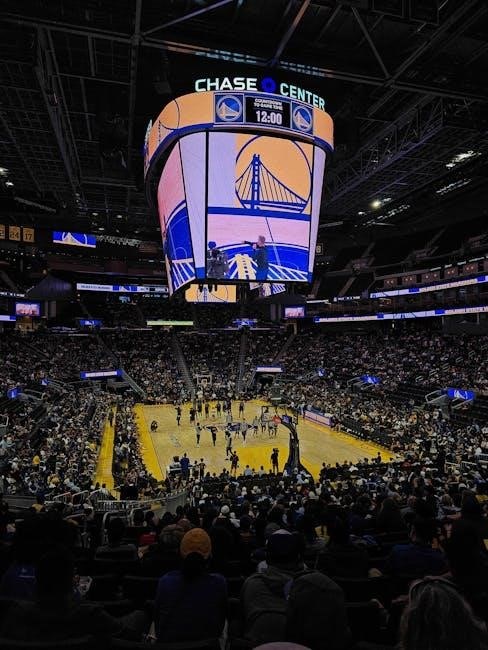The 5-Out Offense is a dynamic, spread-based system emphasizing spacing and player movement. Popularized by teams like the Los Angeles Lakers, it maximizes flexibility and scoring opportunities.
1.1 What is the 5-Out Offense?
The 5-Out Offense is a basketball strategy characterized by spreading all five players outside the 3-point line. It emphasizes spacing, player movement, and dynamic ball distribution. This system allows for maximum court vision and flexibility, enabling players to exploit defensive gaps. Popularized by modern teams, including the Los Angeles Lakers, it blends individual creativity with structured principles. The offense is designed to create open shots, driving lanes, and post-up opportunities through precise execution and teamwork. Its adaptability makes it a cornerstone of contemporary basketball strategies.
1.2 Importance of the Playbook in Modern Basketball
The playbook serves as the foundation of modern basketball strategies, ensuring alignment among players and coaches. It outlines set plays, defensive schemes, and offensive systems like the 5-Out Offense. For teams like the Los Angeles Lakers, a detailed playbook is crucial for consistency and adaptability. It allows for quick in-game adjustments and provides a common language, enhancing execution under pressure. A well-structured playbook is essential for competing at the highest levels, fostering teamwork, and maximizing player potential.

Basic Principles of the 5-Out Offense
The 5-Out Offense relies on spacing, player movement, and ball distribution to create scoring opportunities. It emphasizes fluidity and teamwork to exploit defensive weaknesses effectively.

2.1 Spacing and Positioning
Spacing and positioning are the cornerstone of the 5-Out Offense, ensuring maximum court coverage. Players are positioned around the perimeter and high post, creating driving lanes and shooting opportunities. The five-out setup forces defenses to spread, limiting help defenders; Each player must understand their role in maintaining spacing to avoid cluttering the paint or perimeter. Proper positioning allows for fluid ball movement and player cuts, making the offense unpredictable and difficult to defend. Discipline is key to executing this system effectively.
2.2 Player Movement and Cutting
Player movement and cutting are essential to the 5-Out Offense, creating scoring opportunities through intelligent off-ball actions. Players use flash cuts to the basket, weakside rotations, and backdoor cuts to exploit defensive gaps. These movements are designed to capitalize on defensive miscommunications and overcommitments. The Lakers’ playbook emphasizes timing and precision in cuts, ensuring that each action aligns with ball movement and spacing. This dynamic approach keeps defenses guessing and opens up high-percentage scoring chances consistently.

2.3 Ball Movement and Passing
Ball movement and passing are critical components of the 5-Out Offense, designed to break down defenses through precision and timing. Players are expected to deliver the ball to open teammates quickly, creating scoring opportunities. The Lakers’ playbook emphasizes the importance of skip passes, flash feeds, and drive-and-kick actions to exploit defensive gaps. Effective ball movement forces defenses to rotate, leading to open shots or attacking lanes. This systematic approach ensures that every pass has a purpose, maximizing offensive efficiency and flow.

Key Personnel Roles
The 5-Out Offense relies on distinct roles: the point guard initiates plays, wings create scoring opportunities, and big men set screens and roll to the basket effectively.
3.1 Point Guard Responsibilities
The point guard is the offensive catalyst, responsible for initiating plays and maintaining rhythm. They must read defenses, deliver precise passes, and create opportunities through penetration or shooting. Effective decision-making and court vision are critical. They often set the tone with ball movement and player positioning, ensuring the offense flows smoothly. Their ability to balance scoring and playmaking is vital for the system’s success.

3.2 Wing Players’ Contributions
Wing players are versatile scorers and playmakers, essential for the 5-Out Offense’s success. They create shots through cuts, drives, and spot-up opportunities. Their ability to attack the basket and shoot from the perimeter stretches defenses. Wings also facilitate ball movement and set screens to free teammates. Quick decision-making and the ability to read defenses are critical. Their versatility allows them to adapt to various game situations, making them key contributors to the offense’s fluidity and effectiveness.
3.3 Big Men’s Role in the Offense
Big men in the 5-Out Offense serve as versatile anchors, providing interior scoring and rebounding while facilitating ball movement. They set screens, roll to the basket, and finish at the rim. Their ability to seal defenders in the post creates scoring opportunities. Additionally, they often act as high-post facilitators, making smart decisions to pass or shoot. Their presence balances the perimeter-oriented attack, offering a reliable inside-out threat that defenders must account for. Their adaptability enhances the offense’s overall effectiveness.

Core Plays in the 5-Out Offense
- Flash Action: Quick ball movement and cutting to create open shots or driving lanes.
- Weakside Action: Off-ball movement on the opposite side of the court to exploit defensive gaps.
- Post Actions: Utilizing big men in the paint for scoring or drawing fouls.
4.1 Flash Action
The Flash Action is a quick-hitting play designed to create immediate scoring opportunities. It involves rapid ball movement and precise cutting to exploit defensive gaps. Typically initiated by the point guard, this action aims to catch the defense off balance, leading to open perimeter shots or driving lanes. The Lakers’ playbook emphasizes timing and spacing, with wings and bigs making sharp cuts to the basket or popping out for open looks. This play is a cornerstone of the 5-Out Offense, showcasing its ability to pressure defenses with speed and precision.
4.2 Weakside Action
The Weakside Action is a complementary play to the Flash Action, focusing on creating scoring opportunities on the opposite side of the court. It often involves staggered screens and sharp cuts to free up shooters or drivers. This action is designed to exploit defensive rotations and mismatches, keeping the defense guessing. By maintaining balance and spacing, the Weakside Action ensures the offense remains unpredictable, even after the initial Flash Action. It’s a key component of the Lakers’ 5-Out Offense, emphasizing timing and player chemistry.
4.3 Post Actions
Post Actions in the 5-Out Offense involve utilizing the high and low post to create scoring opportunities. Players seal defenders in the paint, receiving entry passes from guards or wings. The spread formation allows for clear driving lanes and high-low passing options. Post players must be adept at scoring with both hands and drawing fouls. This action is particularly effective against smaller lineups, exploiting mismatches and defensive shifts. It’s a reliable way to generate points when perimeter shots aren’t falling.

Strategic Considerations
Strategic considerations in the 5-Out Offense focus on maximizing spacing, exploiting mismatches, and adapting to defensive schemes. Coaches must balance player strengths with game situations.
5.1 Strengths: Creating Space and Flexibility
The 5-Out Offense excels at creating space and flexibility, allowing players to exploit defensive gaps. By spreading the floor, it enables effective perimeter shooting and driving lanes. This setup forces defenses to make difficult choices, often leading to mismatches or open looks. The offense’s flexibility also adapts to various player strengths, making it challenging for opponents to anticipate the next move. This balance of structure and freedom is a key advantage in modern basketball.
5.2 Weaknesses: Vulnerabilities in Defense

The 5-Out Offense can expose defensive vulnerabilities, particularly in transition and perimeter defense. Its spread nature often leaves gaps in help defense, making it challenging to protect the paint and perimeter simultaneously. Over-reliance on outside shooting can lead to defensive breakdowns during closeouts. Additionally, the offense’s flexibility requires precise rotations, which can be exploited by opponents if not executed flawlessly. Teams with strong rebounding and fast-break capabilities can further capitalize on these defensive weaknesses, making adjustments crucial for sustaining defensive integrity.
5.3 Adjustments for Different Game Situations
The 5-Out Offense requires adaptability to thrive in various game scenarios. Coaches often tweak spacing and player movement based on opponent strengths and game flow. In close games, emphasizing ball movement and high-percentage shots is crucial. When trailing, the offense accelerates the pace to create transition opportunities. End-of-game situations call for precise execution of set plays. Adjustments may also involve isolating key players or exploiting defensive mismatches, ensuring the offense remains unpredictable and effective regardless of the game’s stage or defensive approach.

Evolution and Adaptability
The 5-Out Offense has evolved significantly, blending historical strategies with modern innovations. Its adaptability ensures effectiveness across different eras and player personnel, keeping it relevant in today’s game.
6.1 Historical Use by the Lakers
The Los Angeles Lakers historically utilized the 5-Out Offense to create spacing and exploit matchups. This system, popularized during their championship runs, emphasized versatility and player movement. By aligning shooters and playmakers around the perimeter, the Lakers maximized scoring opportunities and showcased the offense’s flexibility. Historical adaptations often featured stars like Kobe Bryant and Pau Gasol, who thrived in this framework. The offense’s evolution with the Lakers laid the groundwork for its modern applications, blending tradition with innovation to remain effective in competitive eras.
6;2 Modern Adaptations and Trends
The 5-Out Offense has evolved significantly, with modern teams incorporating small-ball lineups and increased 3-point shooting. The Lakers have adapted this system to feature faster-paced, perimeter-oriented attacks. Recent trends include more off-ball movement and sophisticated cuts to create open looks. The integration of versatile big men who can shoot and handle the ball has further enhanced the offense’s flexibility. These modern tweaks have kept the 5-Out Offense relevant in today’s fast-paced, spacing-focused NBA.
The 5-Out Offense has proven effective, with the Lakers showcasing its adaptability. Its success in modern basketball highlights its continued relevance and potential for future innovation.
7.1 Summary of Key Points
The 5-Out Offense, as seen in the Lakers’ playbook, emphasizes spacing, player movement, and ball distribution. It creates scoring opportunities through structured flexibility. The system relies on guards and wings to initiate actions, while big men play a crucial role in post and perimeter dynamics. Flash, weakside, and post actions are core components, allowing adaptability to modern basketball trends. This offense balances individual creativity with team execution, making it a versatile and effective system for competitive play.
7.2 Potential Future Developments
The 5-Out Offense may evolve by incorporating more 3-point shooting and advanced analytics for play design. Teams could integrate AI-driven systems to optimize real-time adjustments. Additionally, the offense might adopt hybrid elements, blending with other systems like small-ball lineups. Increased focus on versatility and defensive counters could enhance its effectiveness. As basketball advances, the 5-Out Offense will likely remain a cornerstone, adapting to modern trends while maintaining its core principles of spacing and fluid movement.
